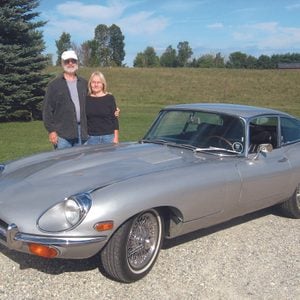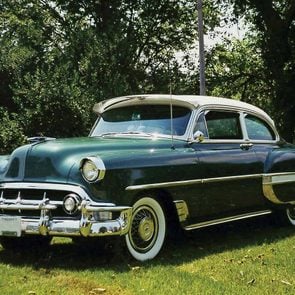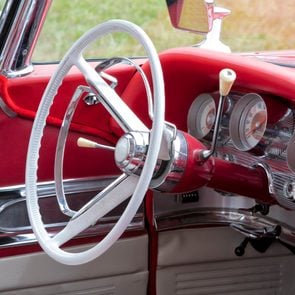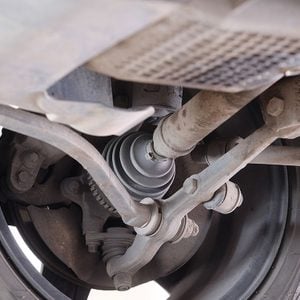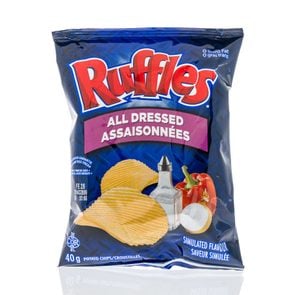Brakes are your car’s most important safety feature. Made up of several different parts and components, they are designed to be noisy when they’re going bad, which is a good thing. It’s definitely better to find out your brakes are going bad from hearing a squeak than by not being able to stop! Fortunately, most brake noises are considered normal and do not indicate a problem. (Here are nine strange car noises—and what they could mean.)
Constant or strange brake noise can be a sign that your brake hardware simply needs to be lubricated. Or it can be a warning that components in the brake system are wearing out or need to be serviced. So take the common sense approach. Check your brakes if they’re consistently noisy or the noise appears to be increasing. With brakes, it’s always better to be safe than sorry.
How Brakes Work
Brake pads are made of friction material attached to a steel backing plate. When you apply the brakes, fluid pressure forces the brake calipers to clamp the pads down on the disc rotors, creating heat. It is this heat (friction) of the pads pressing against the rotors that slows and stops your car.
Why Are My Brakes Squeaking?
Brakes squeak, squeal or screech when vibrating brake pads produce a sound in a specific frequency. That sound, however, doesn’t mean your brakes are failing. If your brakes grind or grab, or your car pulls to one side when braking, that’s a different story. In those cases ask a mechanic to check your brakes immediately. (Here’s what to do if your car shakes when braking.)
Specific Causes of Brake Noise
Temperature change
- That, or an overnight a light layer of rust can form on a rotor, making brakes squeal. Once brake pads and rotors heat up, the noise stops. Nothing to worry about.
Wear indication
- Some pads come with a wear indicator that produces a loud squeal when the friction material is worn down, indicating the pads need replacing.
- Brake pad friction material can be made from composite materials including semi-metallic, non-asbestos organic [NAO], low-metallic NAO and ceramic.
- Semi-metallic pads have great stopping power, but are noisy and cause premature rotor wear.
- NAOs reduce vibration, but wear quickly.
- Low-metallic NAO also have excellent stopping power, but are noisy and dusty.
- Ceramic pads, the most costly, provide good stopping power, plus are quieter and produce little rust or dust.
Worn, broken or missing brake hardware
- Worn or missing shims, clips, springs or loose fasteners are the main causes of brake noise. Any of those will cause pads to drag on the rotors, overheat, vibrate, and wear unevenly and more quickly.
How to Fix Squeaking Brakes
Replacing brake pads and the hardware causing the squeak can be a DIY job. Many automotive supply stores will lend you specialty tools to replace brake pads. Rotors that are glazed (smooth and shiny) or scored from excessive pad wear and tear, or a brake pedal that pulsates up and down when stopping, all indicate the rotors need to be refinished or replaced.
Do some research to determine if you can replace the rotors yourself. And remember, safety first. Always wear a mask, safety glasses and gloves when replacing brakes.
Pro tips for a successful fix:
- Always replace all brake hardware (anti-rattle and spring clips) when installing new pads. Many applications call for covering the backing plates with anti-squeal lubricant, high-temperature silicone insulation gel or Teflon shims that absorb braking vibration.
- Clean all hardened steel parts (such as caliper slide pins) by soaking them in non-chlorinated brake cleaner (not degreaser) and using a plastic brush. Do not “break” the hardened finish by cleaning with a file or wire brush.
- Be sure to clean all contact points of rust and corrosion and lube all mating parts and slide pins with special brake grease or anti-seize compound.
- Avoid getting lubricants or greases on the pad friction surface.
- When finished, place a pan under the rotors and give them (not the pads) a thorough cleaning with brake cleaner to remove any grease or fingerprints before installing the wheel.
Next, find out what it could mean when your brake light comes on.
It’s more than 50 years now since the French automaker Citroen brought out the model designated DS19.
As soon as it came to market, my husband Fred was entranced. He swore that he would get one of those cars. We were living in France at the time, so he came across numerous DS19s to drool over. It took about a year, but eventually one was put up for sale, secondhand, from a civilian member of our Canadian Forces community, and so we became the proud owners of the dear car we called Snoopy.
Snoopy got his name because he had a rather long nose, just like the lovable beagle made famous by Charles M. Schultz in his comic strip Peanuts, starting back in the 1950s. Our Snoopy had one truly singular feature—he could raise himself up off the wheelbase and lower himself down again. The suspension included a variable-height adjustment that could be used for clearing road hazards, fording streams, or even jacking up the car when changing a flat. And, most conveniently, the driving height of the vehicle was adjustable from inside the car. This feature was not so much needed in France, but was wonderful back in Canada, as Snoopy could rise over snowdrifts with ease!
In many other ways, the DS19 was an exceptional car. Easy to drive, comfortable and ahead of its time in the 1950s, Snoopy was the best car we ever had.
Next, find out the most popular car the year your were born.
It seems like every day there’s a new car myth to debunk. Will regular tune-ups really extend the life of your car? How about the idea that cold engines need to be warmed up before driving? Here’s one car conundrum that’s not only true, but can be downright dangerous if left unaddressed.
A weighted question
How can the keys on your keyring have any real effect on the ignition, you may be wondering? Jake McKenzie, content manager for autoaccessoriesgarage.com, explains: “Too many keys on your keyring can damage the sensitive interior components of your ignition cylinder. Your ignition cylinder really wasn’t engineered to hold much weight on it, and when you hang a heavy keyring from your ignition every bump, turn and vibration will slowly but surely wear down the delicate inner elements.” Find out 13 other ways you’re shortening the life of your car.
A (car) accident waiting to happen
Wearing down the ignition cylinder could ultimately lead to intermittent starting problems or other major safety issues. Lauren Milligan, a career advancement coach at ResuMAYDAY, shared this story: “My husband, years ago, had probably three dozen keys on his ring. The weight shifted around the ignition so badly that while he was driving, he could pull the key out of the ignition and continue to drive. Before that happened, my husband’s mechanic warned him plenty of times about how his key ring was too heavy.” Yikes!
So it’s not the keys themselves that are the problem—it’s the weight of the keys hanging from the ignition that’s the issue. While there is no professional consensus on how many keys are too many, most experts agree that five or six keys should really be the max amount. An even better option is to have your ignition key on its own keyring to completely reduce the weight pressing down on the ignition. While this may seem like a small thing, it can end up creating costly repercussions. So ditch the heavy key ring and travel light—your car ignition will thank you.
Next, check out 13 more things you should never do to your car.
[Additional sources: Brightside.me, Patch.com]
I had my first Caesar when I was 19. My mom made one for me. Knowing I’m not the biggest fan of seafood, she didn’t explain that there was clam juice in it. I took my first sip of this unfamiliar concoction—a blend of vodka, tomato juice, clam broth, hot sauce and Worcestershire sauce—and knew I’d found my soulmate in cocktail form.
You don’t drink a Caesar as much as you savour it—the combined intensity of flavours, spice and saltiness force you to sip more slowly than you would a glass of wine or a pint of beer. “Mindful” may be a widely-used buzzword nowadays, but that’s exactly how I feel when I have a Caesar in hand.
And of course, I’m not alone.
On average, Canadians consume a whopping 350 million Caesars every year. In 2007, viewers of the CBC television special The Greatest Canadian Invention voted it 13th—beating out the likes of basketball, lacrosse and the Canadarm. And two years later, an Ipsos-Reid poll determined it was the country’s most popular cocktail.
But there’s more to the Caesar than meets the eye. Here are the fascinating origins of this bona fide national treasure.
Who Invented the Caesar?
Walter Chell, a Calgary restaurant manager, is widely credited with inventing the Caesar in 1969. An Italian immigrant, Chell had been tasked with creating a signature drink for a new restaurant at the Calgary Inn. Inspired by the flavours of spaghetti alle vongole (spaghetti with clams), Chell decided to mix vodka with clam and tomato juice, hot sauce, Worcestershire and a few other spices.
“I think he’d be proud of what came about and how he had a hand in it,” says Giovanna Chell of her father, who passed away in 1997. “How many countries even have a national cocktail?”
Still, there are other versions of how the famed cocktail came to be: some purport it can be found in a Betty Crocker cookbook from 1951, while others claim a bartender at Caesar’s Palace in Las Vegas created the drink at the request of crooner Tony Bennett. And of course, the forerunner to the Caesar, the Bloody Mary, has a history of its own (though it famously did not become popular in Canada).
The Battle for the Caesar
First introduced to Canada in 1966, the popularity of Mott’s Clamato is forever tied with the Caesar. In 2018, The New York Times reported that although Clamato is produced in the United States, one-third of its North American sales are in Canada—and according to Mott’s, most of it is used to make Caesars. Like many famous brands, however, it once found itself at the centre of a high-profile lawsuit.
In 1988, Cadbury-Schweppes—which owned Mott’s Clamato at the time—sued FBI Foods, claiming that the latter’s “Caesar Cocktail” juice line was a violation of the original Mott’s Clamato recipe. The lawsuit, which reached the Supreme Court of Canada, did not go in Cadbury-Schweppes’s favour, however: the Honourable Ian Binnie concluded that the recipe itself was not unique enough. (Mott’s had not actually patented the formula and, more critically, the “Caesar Cocktail ” did not contain clam juice.)

What Makes the Caesar So Special?
You need fewer than 10 ingredients to make a Caesar: vodka, Mott’s Clamato juice, Worcestershire sauce, Tabasco sauce, salt and pepper, celery salt for the rim of your glass and celery to garnish. But the beauty of the Caesar, according to many, is its ability to stand up to experimentation.
“There are really no rules,” says London Richard, a mixologist who co-owns Sorso in Airdrie, Alberta. “As long as you stick to the basics—the heat element, Worcestershire, and Mott’s Clamato, everything outside of that is up to the imagination.” In 2021, Richard won Mott’s Best Caesar in Town Competition with the “Suffering Caesar,” which features scotch bonnet hot sauce and mango nectar, drawing on flavours from the Caribbean.
“It started off as a simple cocktail, but over the last decade, it’s been elevated,” adds restaurateur Matthew Heyne, the owner of the Cow Café in Cowichan Bay, B.C. His take—christened the “Coast to Coast Caesar”—is topped with lobster, scallops and other seafood, and made it to the final round of the Mott’s competition.
For me, it goes deeper than that. Like Walter Chell, my mom, who introduced me to Caesars, is an immigrant to Canada, a country built on contributions by people originally from other places. And our national cocktail was created by an immigrant who took a classic idea and created something new with it. What could be more Canadian than that?
Where to Find the Best Caesar in Canada
Bars and restaurants across Canada continue to interpret the Caesar in the most surprising—and extravagant—ways:
- La Terrasse in Ottawa serves a Caesar-for-two in a massive fishbowl, topped with shrimp and sliders.
- The Merchant Tavern in St. John’s serves their version of the Caesar with a freshly shucked Atlantic oyster and cured meats.
- Score on Davie in Vancouver offers nine variations on the Caesar, including one creation paired with deep fried mac and cheese balls, pickles and onion rings.
- Social Beer Haus in Calgary serves a citrus vodka-based Caesar topped with smoked cheese and spicy sausage links.
My Own Special Caesar Recipe
As a Caesar superfan, here’s one that I’ve developed myself over the years. It’s simple and classic—but a few additions bring out the briny and spicy flavours especially well!
- 1 oz. vodka
- 2-4 dashes hot sauce (to taste)
- 1 dash ground pepper
- 4 dashes Worcestershire sauce
- 1-2 tsp. pickle juice brine
- 1 dash soy sauce
- 1 generous squeeze lemon or lime
- 8 oz. Mott’s Clamato juice
- Rim with celery salt, garnish with citrus or a pickle (if you’re feeling funky)
- Stir in a few ice cubes (mix well)
- Enjoy!
Now that you know the origins of the Caesar drink, check out these iconic Canadian dishes—and the best places in the country to find them.

Princess Diana’s revenge dress
In June 1994, Princess Diana wore an off-the-shoulder, form-fitting black silk dress that would go down in history. Despite being estranged and separated from Prince Charles since 1991, Diana still embodied an elegant radiance, even if the daring number broke royal protocol. The iconic dress was soon dubbed the “revenge dress” because of a huge confession that was heard around the world that very same night.
Two things happened on that fateful night—Princess Diana made a public appearance at a party hosted by Vanity Fair and Prince Charles’s tell-all documentary premiered on national television. The documentary was made in an effort to bring Prince Charles back into a more sympathetic light after his separation from Diana, who was loved by all as “the people’s princess.” Unfortunately, the film’s intent backfired when the interviewer asked Charles on screen if he’d been “faithful and honourable” to Diana during their marriage. “Yes,” Prince Charles answered. “Until it became irretrievably broken down, us both having tried.” His subtle confession was all it took to land the prince back in hot water again. (Check out the most scandalous royal memoirs ever published.)
“We call it the ‘revenge dress’ [because] she wore it the same evening Prince Charles confessed to his adultery with Camilla,” said Kerry Taylor. Taylor’s company auctioned off ten of the most recognizable Diana dresses back in 2013. “While some would have been like, ‘I can’t face it this evening,’ Diana went out in that dress looking drop-dead gorgeous. She made a big statement.”
But we may never know Diana’s true intentions for wearing the iconic black dress, since the designer Christina Stambolian revealed that the dress had actually been made for Diana three years prior to its first appearance in the spotlight. At the time, the princess had been too nervous to wear it because she claimed it was “too daring.” In fact, Diana had initially planned on wearing a different dress until her outfit of choice was released to the press ahead of the event, according to reports from the Telegraph. Instead, she made a last-minute switch and opted for the “daring” Stambolian black dress. Anna Harvey, her former stylist, said that she wanted to “look like a million dollars” that night. If the dress was Diana’s small act of revenge, she sure did look like a million bucks doing it.
Next, learn how Princess Diana confronted Camilla about the affair.
Reader’s Digest Canada: There’s some controversy around who invented daylight saving time—some say it was Benjamin Franklin. Care to weigh in?
Blake Shaffer: I don’t think you could say Franklin invented it, but he was one of the first people to point out the folly of sleeping away the daylight hours, which he did in a satirical essay published in 1784. We do know that Port Arthur, Ontario (now Thunder Bay) was the first place in the world to implement DST, in 1908, so that’s kind of a claim to fame for our country.
Why there of all places?
Societies further from the equator tended to adopt the time shift, since those closer don’t get the big swings in daylight hours. As to why Port Arthur specifically did it first, I’m not sure. But DST then became widely adopted during the First World War, when it was seen as a way to save energy by burning less coal.
In 2005, George W. Bush expanded it so that we spring forward in March instead of April and turn the clocks back in November instead of October. That was part of the Energy Policy Act of 2005, so it was still tied to the idea that DST saves energy.
Does it?
Definitely not in the same way it once did. Lighting technology has evolved so much even over the last 20 years: LED lighting uses up to 80 per cent less electricity than incandescent bulbs did. That said, last year my colleague Nic Rivers at the University of Ottawa published research that showed a 1.5 per cent reduction in energy in Ontario during DST. That’s a big deal, so I replicated the experiment in Alberta, where I live—and got the exact same result. But in any case, some Albertans would rather have sun in the morning. We’re a more agrarian society, so we tend to be early risers compared to Ontarians, who really like their sleep. Obviously, that’s a massive generalization… I don’t want to offend anyone!
No offence taken. I’m an Ontarian and I am 100 per cent #TeamDST. Is there anything better than long summer nights?
Well, one’s individual lifestyle is a big factor. If you’re a golfer, you might be a huge fan of DST because it means you can be on the course until after 10 p.m. If you’re a parent trying to get your children to school, you might prefer that hour of light in the morning. As the father of four, I can tell you that even just those few days of adjustment can be extremely trying. In our house, the kids set the schedule, regardless of what the clocks say.
I’ve heard that DST causes detrimental effects to our health. Should that be considered?
When the clocks go forward, there is a demonstrable spike in heart attacks—and traffic accidents—based on losing an hour of sleep. But also, brighter nights are associated with more physical activity in the evening and a higher average caloric burn. Again, there are pros and cons to both.
There was a study seven years ago that claimed DST led to a spike in “cyberloafing”—that is, wasting time on the Internet. Have you heard of this?
Yes, but I’m not sure that’s caused by DST. I guess if we’re going to attribute being tired to the time change, we can blame DST for a lot of things.
But not being late. Smart clocks have mostly taken care of that.
They have, but I still use manual clocks in one of our cars and on my stove. Also, the other day, Nic Rivers was supposed to call me at 9 a.m., and by 9:10, I was looking at the time and wondering why he was late. I had forgotten that he was in France, where they go back and forth in October and at the end of March.
If two DST experts can’t get a handle on it, what hope is there for the rest of us?
That’s fair. We said the same thing.
Here are the biggest myths about daylight saving time—debunked.
Removing the peel from a clove of garlic demands a great deal of time and patience. Then, when all is said and done, you end up with sticky, garlicky hands for days! But luckily for home cooks everywhere, there’s an easier way—and it takes less than a minute. Instead of struggling with a knife or shaking cloves in a jar, use this quick and easy trick for peeling garlic in no time.
The Easy Way to Peel Garlic
Here’s the secret: You pop the clove into the microwave for 20 seconds. That’s it! After it’s been heated, the skin will peel right off with no work necessary. You’ll want to trim the top of the bulb and peel away any easy-to-remove bits of skin first, but otherwise you’re good to go, and ready to make the garlic recipes of your dreams.
@k_ali98easy way to peel garlic – heat for 30 secs in microwave and they just slip right out! ##cooking ##hack ##foryou ##foryoupage ##asmr ##garlic ##tasty ##kitchen♬ original sound – kushi ali
Be sure to let the garlic sit for at couple seconds before touching it, though. It can be hot coming out of the microwave!
Does This Hack Really Work?
Yes! When I tried this hack on a single clove of garlic, I actually found it took less time to remove the skin than the 20 seconds advertised. After just 14 seconds in the microwave, out came a completely smooth clove with a peel that was removed in just one pull.
I found that when the garlic heated up, though, it became soft and broke easily—it was essentially steamed in the microwave, after all—so you’ll want to give it a few minutes to cool before chopping or grating. Compare that to the time you’d normally spend fussing with the skin and scrubbing your hands, and this kitchen hack emerges as the clear winner. Bon appetit!
Now that you know how to peel garlic, check out our best-ever kitchen hacks.

Cover Story
Only Good News
2022 wasn’t all bad. Here’s a year’s worth of heartwarming, world-shaking, awe-inspiring and straight-up happy-making reasons to smile.
Drama in Real Life
Swept Away!
If the hydro workers didn’t act fast, Sherry Vyverberg would be carried over Niagara Falls or caught in the swirling blades of the powerhouse turbines.
Life Lesson
Dishing Dirt
Not all gossip is bad. How to quash the mean-spirited kind.
Health
Buzz Kill
New studies show that even moderate drinking is a health hazard. Here’s a frank look at the gruesome toll alcohol takes on the body.
Medical Mystery
Blame Game
If it wasn’t her weight, what was causing her pain?
Inspiration
Between the Lines
Canadians share their fondest memories of Reader’s Digest, and what the magazine has meant to them over the past 75 years.
Subscribe to Reader’s Digest Canada
Esther (last name withheld by request) couldn’t afford to be sick, let alone contagious. In 2021, the then 46-year-old was running a licensed daycare out of her house in the Bronx. She also had five children of her own, ages 12 to 19, to keep safe. But on a trip to South Carolina for her eldest son’s graduation in late June, she started feeling unusually weak. “I was walking around for a few hours and it was hot so I thought maybe I was just tired,” Esther says.
A few weeks and several negative COVID tests later, Esther still wasn’t feeling better. She had no energy, felt slightly feverish and was short of breath. But taking time off to see a doctor was out of the question; whatever it was, she would no longer be contagious, and too many other parents depended on her for child care. So she waited, hoping the symptoms would disappear on their own.
By August, though, the lymph nodes under her armpits had become swollen, and her head ached constantly. She also developed an eschar (a button-like sore with a black, scabby centre) on her right flank. At first, she thought it was just a pimple or a boil, but within a week, it was accompanied by a red rash. Esther headed to the emergency room at the nearby Montefiore Hospital.
Doctors examined the abscess—which can be caused by everything from burns to bedsores—and gave Esther antibiotics to prevent infection. They told her to take acetaminophen for any pain and then sent her home.
A turn for the worse
Over the next two days, her symptoms worsened. A spotty, pustular rash appeared on her forehead, chin and cheeks, then spread across the rest of her body. She had a debilitating headache, neck pain, fever and chills, and she couldn’t eat. “I thought maybe it was chicken pox, but I had that when I was a child,” she says. “I was laid down flat. I couldn’t take a shower because I was shivering so much, and I could barely walk from the bedroom to the living room.” Her assistant took over running the daycare, and her husband brought her back to the hospital.
This time she wasn’t sent home. Instead, infectious disease doctors were called in, and the information gathering began.
Esther was born in Ghana but had lived in the United States for 14 years. She had no known allergies, was up to date on her vaccinations, no one else in her family was sick and, other than her trip to South Carolina, she hadn’t travelled anywhere. Previous medical conditions included asthma, occasional migraines and chronic hepatitis B, but otherwise she was healthy. She didn’t have any pets but informed the doctors that she did occasionally have mice in her home, although she always called an exterminator at the first sign of them.
A lumbar puncture (which involves inserting a needle between two vertebrae to remove a fluid sample) ruled out meningitis. A nasal swab that can detect the flu, whooping cough and bacterial pneumonia also came back negative, and she didn’t have COVID-19, West Nile, HIV or hepatitis C. The doctors had no idea what was causing her symptoms. “I didn’t know what was happening to me, and it was scary,” Esther says.
Honing in on a diagnosis
Because of her rash, fever and persistent headache, the infectious disease team considered Rocky Mountain spotted fever or, more likely because Esther had mentioned a mouse problem, rickettsialpox, which is transmitted by mites that live on mice. Either way, they immediately started her on a seven-day course of doxycycline, a broad-spectrum antibiotic used to treat a range of bacterial infections, including tick-borne illnesses and anthrax.
Rocky Mountain spotted fever has a high mortality rate, so whenever doctors suspect it, they treat it right away, as it can only be confirmed months later with an antibody test, according to Dr. Carissa Windish, who was part of the infectious disease team investigating Esther’s case. The disease is a tick-borne illness, and symptoms include fever, chills, headache and sometimes, but not always, a rash. Untreated, the death rate is up to 80 per cent. Rocky Mountain spotted fever is usually associated with recent travel, but as part of her research, Windish discovered that it had originated in the Bronx in previous cases.
Although the symptoms are similar, rickettsialpox is much more benign and, while unpleasant, will usually resolve on its own in a matter of weeks. The disease was first discovered in New York but is found throughout the world, Windish says. It’s named for the bacteria that causes it (Rickettsia akari), and because the first cluster of cases, which were identified in 1946, were originally misdiagnosed as atypical chicken pox.

A full recovery—from rickettsialpox
Doxycycline is the treatment for both Rocky Mountain spotted fever and rickettsialpox, and within two days of taking the antibiotic, Esther’s fever disappeared, along with her rash. But she still had no idea what had made her so sick. “Sometimes when we use doxycycline to treat a mystery illness, we never find out what was causing the symptoms,” Windish says.
Esther was discharged, although it took a month before she made a full recovery. “I was still so weak, but I had to work,” she says. “After the parents picked up their children, I would just sit in a chair for three or four hours.”
Then, six months later, Windish’s team confirmed the diagnosis of rickettsialpox. Esther was relieved, and grateful. “I am feeling good,” she says. “And I’m happy to say we don’t have mice in the house anymore.”
Next, check out 20 symptoms you should never ignore.

A few years ago, our local Lions Club discussed the fact that other towns have erected large symbols to acknowledge the history of their communities. It only seemed appropriate that with our village’s name association with Remembrance Day, Veteran, Alberta, needed a poppy.
As it says in our local history book, “Where the Prairie Meets the Hills” (originally titled “Wheatbelt”):
“With the coming of the railway in 1912, came the building of the C.P.R. station which was named ‘Veteran.’ There were eight townsites named ‘patriotically’ on this stretch of railway by the C.P.R. All owe their name to circumstances surrounding the coronation of King George V. The townsites were respectively named Fleet, Federal, Coronation, Throne, Veteran, Loyalist, Consort and Monitor. Each name had a distinct relation to the current coronation ceremony. ‘Veteran’ means those who have long been in service of the British crown. ‘Parliament’ and ‘army’ are undoubtedly the distinct symbols for which this little village stands.”
Saluting our poppy, which was erected in November of 2019, is Veteran’s very own war veteran, Private David Pennington, 98 years young at the time. —Judy Bishell
We’re sad to report that Private David Pennington passed away not long after this photo was taken. Below is his incredible story, as told by his daughter, Viola Tkach.

Private David Pennington, The Veteran of Veteran, Alberta
A proud daughter pays tribute to her father and hometown hero.
By Viola Tkach, Our Canada
On August 19, 1943, my father enlisted in the Canadian Army. After boot camp in Grand Prairie and Calgary, he left Alberta as Private David Pennington of the Loyal Edmonton Regiment, part of the First Canadian Infantry. Travelling by train, he headed east to meet the ship that would take him to England and then to the war in Europe.
Dave, as he was known to one and all, joined the war effort near Pachino, Sicily, then the fighting up through Sicily and Italy in the Italian Campaign. Many battles were fought by Canadian soldiers and their fellow Allies while going through Italy. Some of the battles Dave fought in included the Battle of Monte Cassino, Ortona, Hitler Line, Gothic Line, Coriano Ridge and more. In September 1944, the Battle at Coriano Ridge began and Dave was wounded. On that particular day, he was acting as a dispatch runner, being very fast. He was hit by shrapnel and was blown into a ditch full of water. This could have been the end of his story, but soldiers saw what happened and rushed to help him.
Dave was transported to Rome and then to England for a very long convalescence. He always said that the ambulances today have not improved any from that long trek cross country to Rome!
Whenever one of his buddies died, Dave would sing the song, “Beyond the Sunset.” Soon other soldiers began asking him to sing for them, the living, as well.

Dave was discharged from the Canadian Army on March 30, 1946. Images of the war haunted him the rest of his life. In recent years, Dave began to share many of his experiences from the war. He began speaking at the Veteran School in Veteran, Alberta, for Remembrance Day services, telling the students, staff and community his stories; many were not easy to hear.
In 2013, Dave was greatly honoured when the junior high students of the Veteran school lobbied Veterans Affairs Canada to have his medals reissued to him. Major Arcoutte and Sergeant Duncan of CFB Wainwright presented Private First Class David Pennington with his new medals in a very special ceremony hosted by the school. This honoured ceremony was news blasted around the world! The wonderful honour bestowed upon him helped him see a different side of his service and made him so very proud.
Dave was one of ten children born on a farm southwest of Veteran, to Andrew and Agnes Pennington. He spent his early years going to school and helping around the farm. When he got a bit older he spent his free time riding and training horses. This eventually led to trying his luck at bronc riding in many rodeos throughout Alberta, Saskatchewan and Montana—riding in the Calgary Stampede was a major highlight.
Check out more incredible stories from Canadian veterans.



